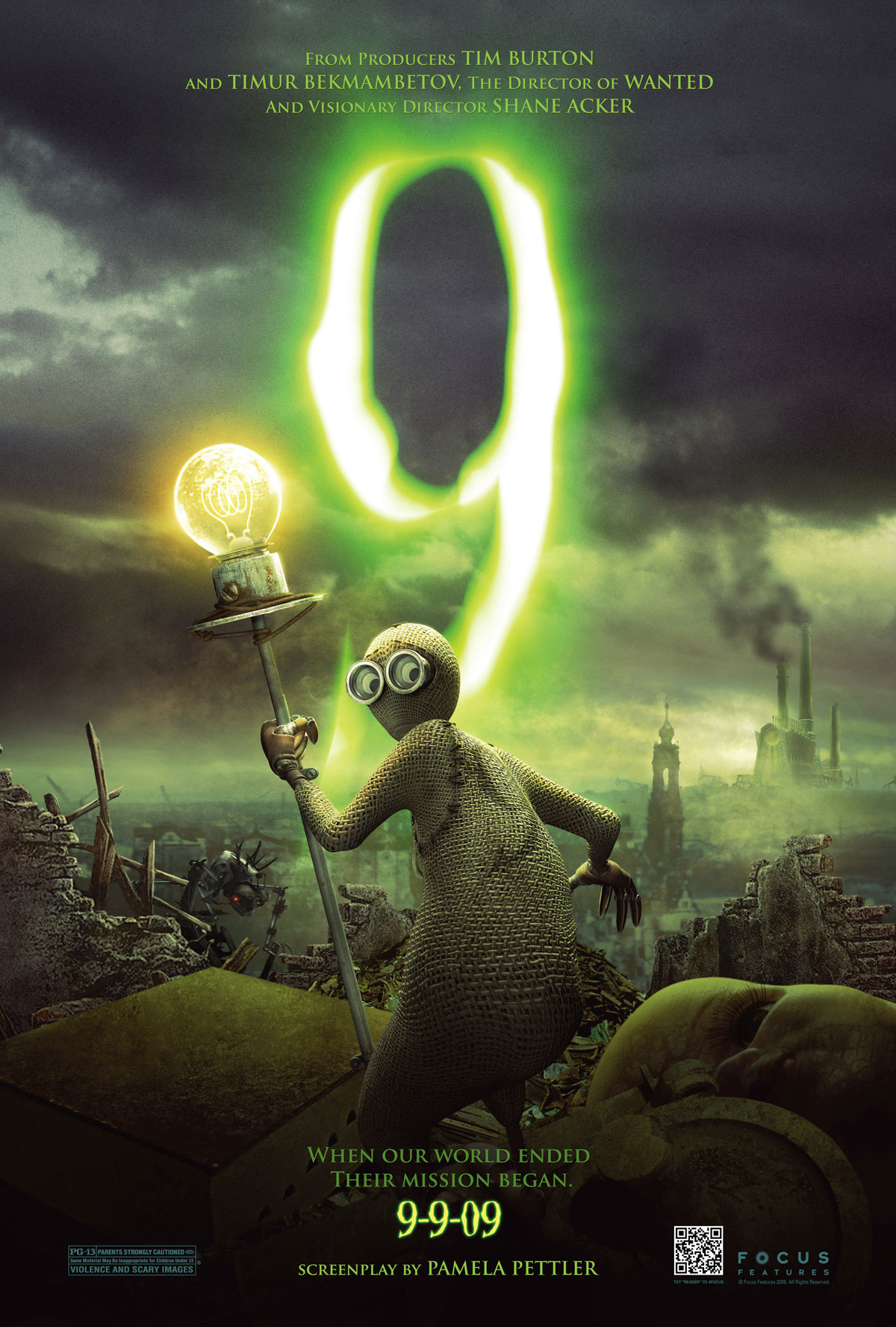Shane Acker’s new feature-length expansion of his Academy Award-nominated short film, 9, features a beleaguered group of sentient ragdolls (officially labeled “stitchpunks”) struggling to survive in the wake of a cataclysmic conflict between human beings and a race of killer war machines, resulting in the apparent extinction of all organic life. Collectively, the stitchpunks represent the last hope and vestige of humanity, laying low, cautiously carving out a life amidst the wreckage and rubble of the dead world around them, cobbling together ingenious tools and contraptions out of the remaining fragments. When the eponymous 9 awakens into this strange and forbidding existence, however, his actions lead to a direct confrontation with an unholy host of diabolical machine-creatures, culminating in a climactic showdown between the forces of Good and Evil, Past and Future, Creation and Destruction, all set against a backdrop resembling some kind of post-industrial, steampunk-y Mordor, belching sinister smoke and flame and robot spiders at every opportunity.
If this sounds a little hackneyed, that’s because it is.
To be fair, 9 is an absolutely stunning film. Visually, it is undeniably breathtaking even in its darkest moments. Acker, production designers Robert St. Pierre and Fred Warter, and art director Christophe Vacher deserve the highest possible praise for bringing this world and its inhabitants to life, creating an atmosphere both somber and luminous: a wasteland still haunted by a few fleeting rays of hope. Unfortunately, the plot and characters seem like an afterthought within the film, functioning mainly to provide an excuse for a cavalcade of ever more intricate and disturbing mechanical monsters to scuttle in and out of frame, engaging our hapless clan of intrepid ragdolls in energetic and highly repetitive battle, again and again and again. And again.
As beautifully animated as the action is, the fight scenes grow increasingly tiresome as the film progresses because there is hardly any meaningful subtext connecting one skirmish to the next—the characters are little more than clusters of loosely-defined personality traits pinned unconvincingly to the arbitrary numbers assigned to them. We know, for example, that 9 is the Hero, 7 is the Courageous Warrior, 6 is the Crazy Artist, and 5 is The Nice One; whether we care about them is a different story.
Furthermore, while the various machine-beasts are certainly impressive (and genuinely unsettling), there is no real villain for an audience to root against, despise, or dread. B.R.A.I.N., the artificial intelligence responsible for the revolt of the machines and the destruction of humanity, barely factors into the action and has no personality. If you’re going to have a rogue A.I. wreaking havoc all over your post-Apocalypse, why not create one with a little flair? A little pizzazz? Engage in some sinister robotic laughter. Twirl an animatronic mustache, whatever. Just give me something. HAL and GLaDOS would eat B.R.A.I.N. for breakfast (though whether that would actually make them zombie A.I.s is another question entirely).
Personally, the only character I was remotely intrigued by at all was arguably the least likeable: the pompous, irascible 1 (voiced by the great Christopher Plummer). At the start of the film, 1’s position as the self-proclaimed leader of the group is reflected in his style of dress, which includes a decorative cape and a tall, mitre-like hat. Combined with the fact that he has taken sanctuary in the ruins of a Gothic cathedral, his finery has the effect of giving him a creepy, ecclesiastical look, like some kind of demented, angry puppet-Pope. (I’m just saying: if the Brothers Quay ever feel like making a short called “Francis Bacon’s Muppet Babies,” I know exactly who they should call…). In any case, 1 is a multi-dimensional character who actually grows and develops over the course of the movie, revealing himself as flawed, fearful, and weak, but not inherently evil or beyond redemption. Sadly, this instance proves the exception rather than the rule in a film which ultimately devolves into a series of stunning visuals stitched haphazardly together with vague plot points and rusty bits and pieces of backstory. Its design is every bit as stunning and ingenious as its protagonists, but for a movie so concerned with the evils of soullessness, there’s very little going on beneath its impressive surface.
Bridget McGovern is a lit nerd, a film geek, and a complete pop culture junkie. She enjoys vampires, David Bowie, roller coasters, and Zardoz more than anyone probably should.










